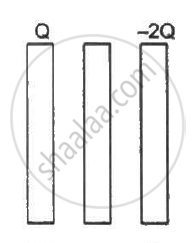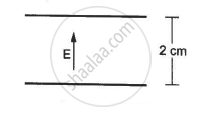Advertisements
Advertisements
प्रश्न
Three identical metal plates with large surface areas are kept parallel to each other as shown in the following figure. The leftmost plate is given a charge Q, the rightmost a charge −2Q and the middle one is kept neutral. Find the charge appearing on the outer surface of the rightmost plate.

उत्तर

Consider the Gaussian surface as shown in the figure.
Let the charge on the outer surface of the left-most plate be q. Thus, the charges on the plates are distributed as shown in the following diagram.
The net field at point P due to all the induced charges must be zero, as it is lying inside the metal surface.
Let the surface area of the plates be A.
Electric field at point P due to the charges on plate X:-
Due to charge (+ Q -q) is `("Q" -"q")/(2"A"∈_0)` in the right direction
Due to charge (+q) is `"q"/(2"A"∈_0)` in the right direction
Electric field at point P due to charges on plate Y:-
Due to charge (-q) is `"q"/(2"A"∈_0)` in the right direction
Due to charge (+q) is `"q"/(2"A"∈_0)` in the left direction.
Electric field at point P due to charges on plate Z:-
Due to charge (-q) is `"q"/(2"A"∈_0)` in the right direction.
Due to charge (-2Q+q) is `(2"Q"-"q")/(2"A"∈_0)` in the right direction
The net electric field at point P:-
`("Q"-"q")/(2"A"∈_0)+"q"/(2"A"∈_0) -"q"/(2"A"∈_0) - "q"/(2"A"∈_0) + "q"/(2"A"∈_0) + (2"Q"-"q")/(2"A"∈_0) = 0`
`("Q"-"q")/(2"A"∈_0) + (2"Q" -"q")/(2"A"∈_0) = 0`
`Q - q + 2Q - q = 0`
`3Q - q = 0`
`"q" =(3"Q")/2`
Thus, the charge on the outer plate of the right-most plate = `-2"Q" +"q" = -2"Q"+ (3"Q")/2 = -"Q"/2`
APPEARS IN
संबंधित प्रश्न
plot a graph showing the variation of current density (j) versus the electric field (E) for two conductors of different materials. What information from this plot regarding the properties of the conducting material, can be obtained which can be used to select suitable materials for use in making (i) standard resistance and (ii) connecting wires in electric circuits?
Two identical circular loops 1 and 2 of radius R each have linear charge densities −λ and +λ C/m respectively. The loops are placed coaxially with their centres `Rsqrt3` distance apart. Find the magnitude and direction of the net electric field at the centre of loop 1.
Plot a graph showing the variation of resistivity of a conductor with temperature.
A metallic particle with no net charge is placed near a finite metal plate carrying a positive charge. The electric force on the particle will be
A charge Q is uniformly distributed over a rod of length l. Consider a hypothetical cube of edge l with the centre of the cube at one end of the rod. Find the minimum possible flux of the electric field through the entire surface of the cube.
Show that there can be no net charge in a region in which the electric field is uniform at all points.
The radius of a gold nucleus (Z = 79) is about 7.0 × 10-10 m. Assume that the positive charge is distributed uniformly throughout the nuclear volume. Find the strength of the electric field at (a) the surface of the nucleus and (b) at the middle point of a radius. Remembering that gold is a conductor, is it justified to assume that the positive charge is uniformly distributed over the entire volume of the nucleus and does not come to the outer surface?
A charge Q is placed at the centre of an uncharged, hollow metallic sphere of radius a. (a) Find the surface. (b) If a charge q is put on the sphere, what would be the surface charge densities on the inner and outer surfaces? (c) Find the electric field inside the sphere at a distance x from the centre in the situations (a) and (b).
Find the magnitude of the electric field at a point 4 cm away from a line charge of density 2 × 10-6 Cm-1.
A non-conducting sheet of large surface area and thickness d contains a uniform charge distribution of density ρ. Find the electric field at a point P inside the plate, at a distance x from the central plane. Draw a qualitative graph of E against x for 0 < x < d.
One end of a 10 cm long silk thread is fixed to a large vertical surface of a charged non-conducting plate and the other end is fastened to a small ball of mass 10 g and a charge of 4.0× 10-6 C. In equilibrium, the thread makes an angle of 60° with the vertical (a) Find the tension in the string in equilibrium. (b) Suppose the ball is slightly pushed aside and released. Find the time period of the small oscillations.
An electric field of magnitude 1000 NC−1 is produced between two parallel plates with a separation of 2.0 cm, as shown in the figure. (a) What is the potential difference between the plates? (b) With what minimum speed should an electron be projected from the lower place in the direction of the field, so that it may reach the upper plate? (c) Suppose the electron is projected from the lower place with the speed calculated in part (b). The direction of projection makes an angle of 60° with the field. Find the maximum height reached by the electron.

Answer the following question.
Prove that the average energy density of the oscillating electric field is equal to that of the oscillating magnetic field.
The force per unit charge is known as ______.
